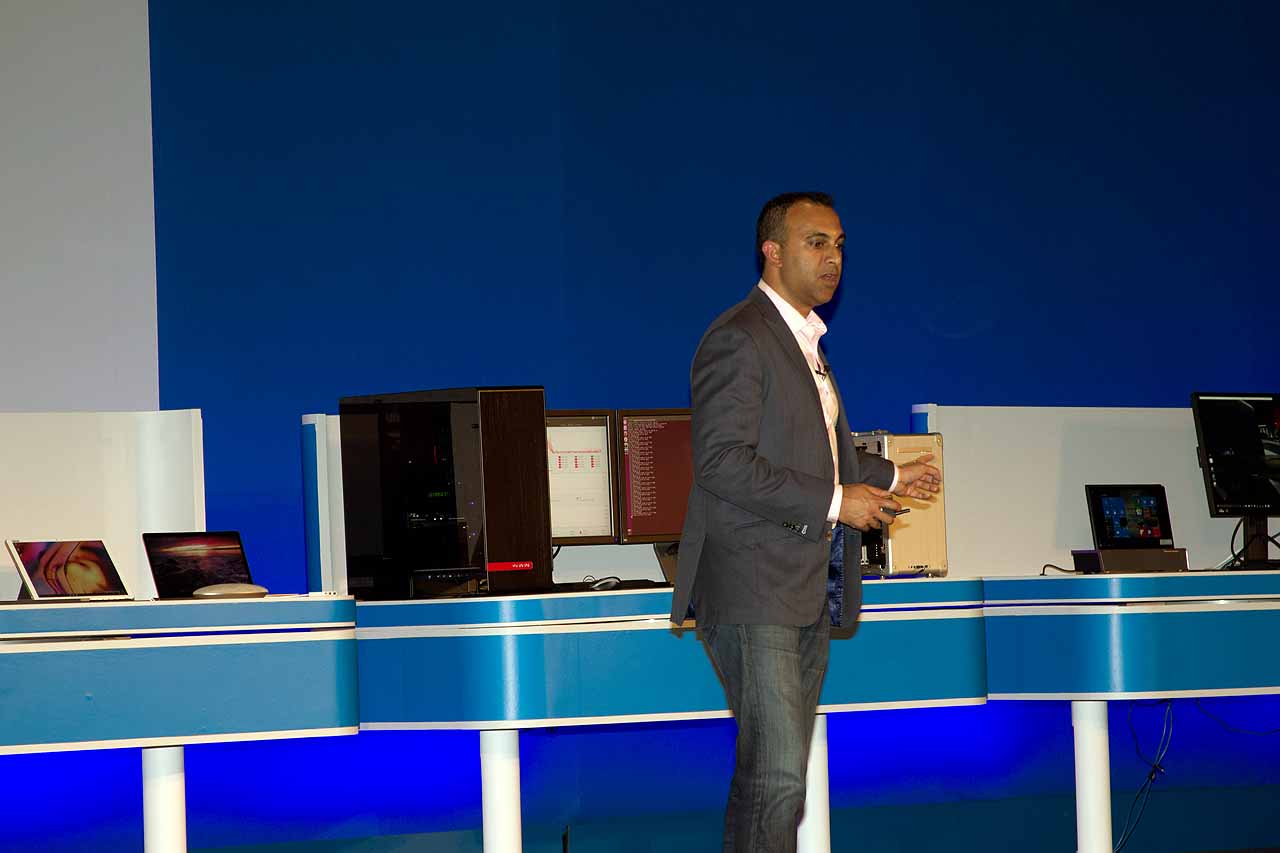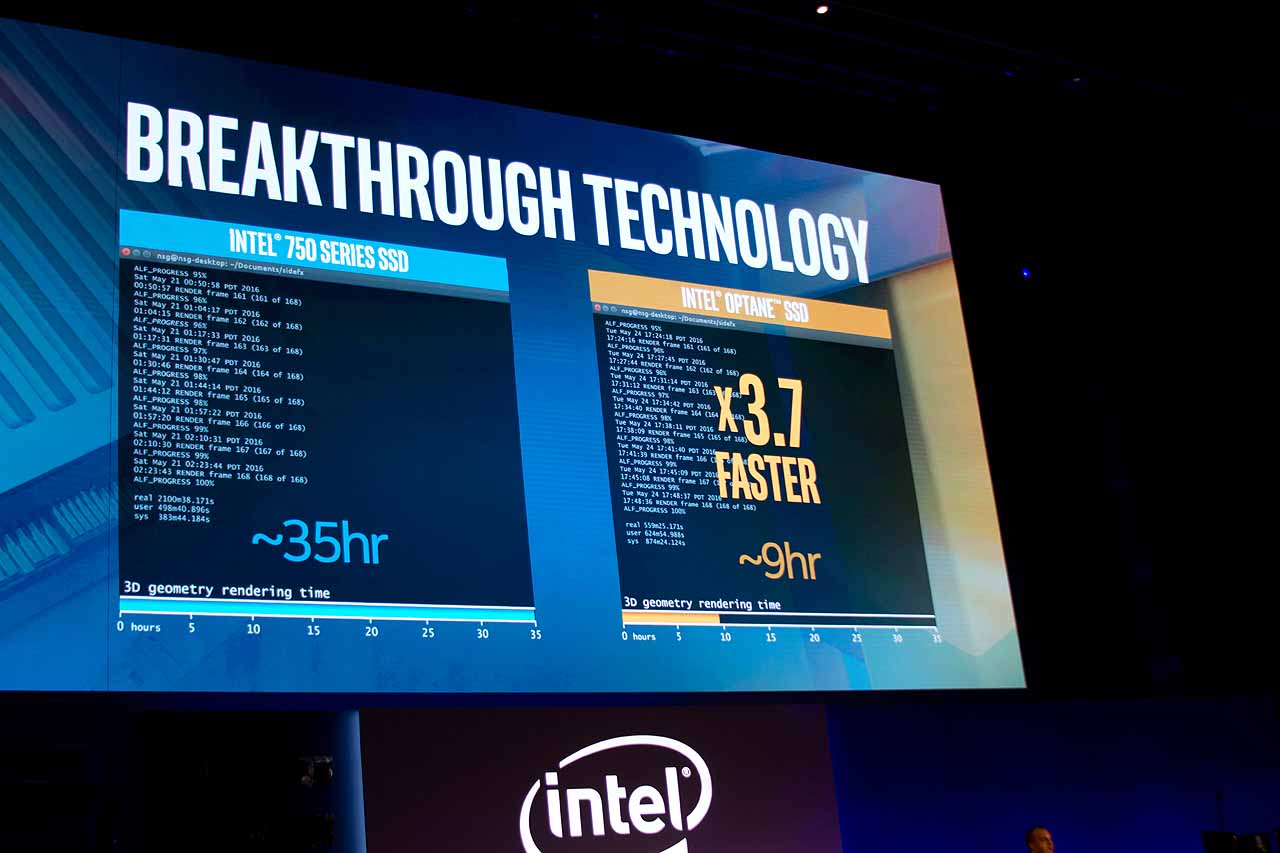Intel Demonstrates 3D XPoint Optane SSD At Computex, Kaby Lake Details Emerge
Intel conducted yet another demonstration of its jointly developed Intel/Micron 3D XPoint technology during its keynote at Computex 2016. A few more details also emerged about how Intel plans to implement 3D XPoint on the Kaby Lake platform.
Intel has long touted the new product, which is the first new memory to be productized in more than 25 years, as a game changer. Unfortunately, both Intel and Micron have been vague about the technology behind the new storage medium, and both companies simply refer back to the now-tired mantra that it is "1000x the performance and endurance of NAND with 10x the density of DRAM."
We know that 3D XPoint is fast, but exactly how fast is up for debate. Intel has demonstrated working 3D XPoint on several occasions, but the demonstrations do not reveal the actual hard performance data, endurance metrics or pricing information (which are the key considerations that will dictate its success). Intel also clearly designs the presentations to obfuscate the underlying performance characteristics, such as using it as a backup device over a Thunderbolt 3 connection (a performance bottleneck).
The Computex demo was more of the same, as the company measured the render time of a fluid dynamics video. The scale of the rendering was impressive. It consisted of 1.1 billion particles and presented itself as a swirl of water that lasted only seven seconds. Surprisingly, Intel indicated that it required 35 hours to render the short clip with a computer sporting "the world's fastest PCIe SSD," which one would assume is an Intel DC P3608.
Intel presented a time-lapse of the rendering process, and the competing 3D XPoint-infused computer was able to render the same video in a mere 9 hours, which is an impressive achievement. However, once again, the presentation did not reveal any concrete performance specifications.
Intel has publicly stated that its upcoming chipsets will support 3D XPoint, and according to motherboard industry sources at Computex, Intel is requiring manufacturers to add 3D XPoint-supporting RAM slots to some Kaby Lake motherboards.
3D XPoint can be used as a normal block-addressable storage device with NVDIMM, PCIe, SAS or SATA devices, but users can only address it as memory (bit-addressable) if it rides the memory bus. 3D XPoint can be used as a block storage device when it is on the memory slot as well, which provides it the advantages of a lower latency connection, thus possibly offering unparalleled storage performance.
Get Tom's Hardware's best news and in-depth reviews, straight to your inbox.
Intel will utilize JEDEC-compliant DIMMs, but motherboard vendors have to add BIOS support for NVDIMM form factor devices. The industry has already adopted a standardized NVDIMM specification, and Micron indicated during its NVDIMM launch that it would use the same architecture for future 3D XPoint-based devices. We have also spotted Intel NVDIMMs in the field.
Using 3D XPoint as memory will also require special software architectures and system optimizations for the applications to utilize the somewhat slower 3D XPoint tier, so it is far from plug-and-play. There are system level optimizations that can abstract the complexity of the dual-tiered memory configuration away from the application, but the emerging software solutions are immature and difficult to implement. However, using 3D XPoint as memory will offer incredible density, up to 10x more capacity per RAM slot, and its lower cost will actually allow us to pursue such lavish accommodations.
Intel's admission that Kaby Lake is 3D XPoint compatible is telling; technically 3D XPoint is compatible with any interface, such as PCIe, SAS/SATA (or even USB 1.0), because the device merely presents itself to the host using standardized interfaces (when used as a block device). 3D Xpoint will require the special considerations that merit the "3D XPoint" compatibility tag only when it is used in a RAM slot.
Kaby Lake is coming later this year, and there is no doubt that 3D XPoint is going to play a big part in the future platform. Using 3D Xpoint-powered Optane SSDs may change our perception of what fast storage means, but utilizing it as a persistent memory tier has the power to change the entire computing paradigm.
Paul Alcorn is a Contributing Editor for Tom's Hardware, covering Storage. Follow him on Twitter and Google+.
Follow us @tomshardware, on Facebook and on Google+.

Paul Alcorn is the Editor-in-Chief for Tom's Hardware US. He also writes news and reviews on CPUs, storage, and enterprise hardware.
-
TDRare So, Intel claims 1000 times the performance, then attempts to impress us with a demonstration that display 3.7 times the performance? That seems to be orders of magnitude below the claimed performance.Reply -
jimmysmitty Reply18055474 said:So, Intel claims 1000 times the performance, then attempts to impress us with a demonstration that display 3.7 times the performance? That seems to be orders of magnitude below the claimed performance.
It is just a demo of course of a certain aspect. We have to consider that this will be both storage and RAM in the future which if we consider the current speed of the best PCIe SSD or even NVMe SSD we are barely pushing 2GB/s while the best DDR4 setup is at about 54GB/s.
Of course we also have to consider that the speed of current NAND is measured at a specific queue depth and sequential speeds.
Of course I don't expect 1000x faster but I am excited as I think it will be awesome to have storage that acts like RAM allowing the entire OS to literally sit in memory and thus load up almost instantly. -
dstarr3 ReplyOf course I don't expect 1000x faster but I am excited as I think it will be awesome to have storage that acts like RAM allowing the entire OS to literally sit in memory and thus load up almost instantly.
That is the dream, innit? I've toyed around with VMs loaded onto ramdisks in the past. Nothing like booting an OS in under 3 seconds.
-
bit_user Let us hope that Intel adheres to the industry standard NVDIMM spec. I'd hate to see yet another proprietary pseudo-standard, like XMP.Reply
I'll buy into this tech when it's standard and well-supported by OS's and software. 'till then, I think good 'ol DRAM + NVMe SSDs will suit me just fine.
-
Samer1970 PCIe lanes ?Reply
DDR4 in dual channel has 34GB/s bandwith ... thats 34 PCIe 3.0 lanes ...
and if quad Channel , 68GB/s thats out of CPU 40 lanes specs ...
Why use PCIe lanes for this ? it is stupid ... make a dedicated link -
bit_user Reply
First, tests involving real-world use cases are never as dramatic as benchmarks fabricated specifically to highlight a specific performance advantage.18055474 said:So, Intel claims 1000 times the performance, then attempts to impress us with a demonstration that display 3.7 times the performance? That seems to be orders of magnitude below the claimed performance.
Secondly, with a little bit of thought, you can perhaps see why it might be difficult to showcase quite what an improvement their new technology offers. Basically, existing systems are architected around the performance characteristics of recent & legacy technology. When disks were slow and mechanical, they were connected via slow, indirect links. As SSDs got faster, they needed to be pulled in closer and closer to the CPU, and connected with ever faster links, in order to provide the full benefits of which they were capable. The system architecture was continually playing catch-up. And as the interconnects improved, the storage devices could co-evolve to expose more of the performance potential of the underlying hardware.
But there's another relevant aspect of system architecture and performance, which is concerning various optimizations and application design principles & practices. Because disks are traditionally many orders of magnitude slower than RAM, operating systems gained increasingly sophisticated disk caching and buffering strategies, employing comparatively fast system memory to mask the long latency and bandwidth limitations of disks. Even at the application layer, programs and APIs have been forced to cater to the performance bottlenecks and limitations of legacy storage. Basically, software developers would typically spend a lot of time and energy optimizing their programs' I/O access patterns to perform reasonably well with existing storage technologies & operating systems.
So, it's really not surprising that, if someone manages to dramatically reduce or eliminate the performance bottlenecks around some part of the system, the relative improvement won't be readily seen in conventional/legacy workloads. This doesn't mean the improvement isn't worthwhile, it just means that applications need to catch up and evolve, in order to fully exploit the performance potential of the new technology.
Maybe because:18056265 said:Why use PCIe lanes for this ? it is stupid ... make a dedicated link
■Optane SSDs are a new product, that's shipping now (or imminently), which they want to sell.
■Kabylake & the associated form of 3D XPoint isn't presently demo-ready.Either way, as Kaby nears launch, I'm sure you'll see plenty of demos involving their new 3D XPoint modules.
-
memadmax It is clear, by a couple of the comments in this article, that some people can't read...Reply -
Vatharian I don't undesrtand this part: "3D XPoint can be used as a normal block-addressable storage device with DIMM, PCIe, SAS or SATA devices, but users can only address it as memory (bit-addressable) if it rides the memory bus. 3D XPoint can be used as a block storage device when it is on the memory slot as well "Reply
It says that XPoint can only be used in bit-addresable, when in DIMM, but then claims it can be used as a block device (until I missed 'memory bus over sata' or 'memory bus over pcie' tech somewhere in between).
How it is, then?
-
Paul Alcorn ReplyI don't undesrtand this part: "3D XPoint can be used as a normal block-addressable storage device with DIMM, PCIe, SAS or SATA devices, but users can only address it as memory (bit-addressable) if it rides the memory bus. 3D XPoint can be used as a block storage device when it is on the memory slot as well "
It says that XPoint can only be used in bit-addresable, when in DIMM, but then claims it can be used as a block device (until I missed 'memory bus over sata' or 'memory bus over pcie' tech somewhere in between).
How it is, then?
An NVDIMM, which in this case is utilizing 3D XPoint, can operate as either storage or memory. Some NVDIMMS allow you to do both simultaneously, you simply partition separate areas of the device to the desired task. -
Samer1970 Reply18056645 said:I don't undesrtand this part: "3D XPoint can be used as a normal block-addressable storage device with DIMM, PCIe, SAS or SATA devices, but users can only address it as memory (bit-addressable) if it rides the memory bus. 3D XPoint can be used as a block storage device when it is on the memory slot as well "
It says that XPoint can only be used in bit-addresable, when in DIMM, but then claims it can be used as a block device (until I missed 'memory bus over sata' or 'memory bus over pcie' tech somewhere in between).
How it is, then?
An NVDIMM can operate as either storage or memory. Some NVDIMMS allow you to do both simultaneously, you simply partition separate areas of the device to the desired task.
Actually I prefer HBM2 CPU with built in memory over using NVDIMM..
it has crazy bandwidth and will reduce the motherboard size dramatically ... will enable us to have 2 cpu in itx form factor and 4 sockets in micro ATX ... and maybe we will have smaler form factor just the size of CPU + slot (chipset in CPU as well)
imagine each cpu comes with 32GB RAM no need for 4 DIMMS at all !!! tinnny pc !!!
even in servers and workstations ... 4 CPU without 16 (4x4) DIMMS !!! WOW !!! very compact !!!


